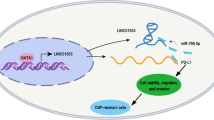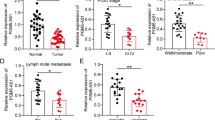Abstract
Purpose
Bladder cancer is the most general malignant cancer in genitourinary system, more than 90% of BCs are bladder transitional cell carcinomas (BTCC). This study aimed to investigate the clinical significance of growth arrest-specific 5 (GAS5) gene and its regulatory effects of malignant proliferation and chemotherapy resistance to doxorubicin in BTCC cells.
Methods
The expression of GAS5 was detected by quantitative real-time PCR. Statistical analysis was used to determine the relationship between GAS5 expression and clinical features and the prognostic value of GAS5 for disease free survival. MTT assay was used to detect cell proliferation ability and chemosensitivity. Dual-color flow cytometric method was used to detect cell apoptosis. The expression of Bcl-2 protein was examined by western blot.
Results
In this study, we found that GAS5 low-expressed in BTCC tissues and cells, and its low expression level had positive correlation with higher pathological grades of BTCC. Moreover, GAS5 was a prognostic biomarker of disease free survival for BTCC patients. GAS5 over-expression could inhibit cell proliferation of BTCC J82 and T24 cells significantly. The IC50 to doxorubicin in T24/DOX cells (resistance to doxorubicin) presented a conspicuous depression, GAS5 enhancement reduced the chemotherapy resistance to doxorubicin. GAS5 over-expression promoted apoptosis induced by doxorubicin in T24/DOX cells, and depressed the expression of anti-apoptosis protein Bcl-2. The results indicated that GAS5 regulated the chemotherapy resistance to doxorubicin via Bcl2 partly.
Conclusions
In summary, lncRNA GAS5 was a prognostic biomarker of disease free survival in BTCC patients, and acted as a tumor-suppressing gene to inhibit malignant proliferation and resistance to doxorubicin in BTCC cells. LncRNA GAS5 might be a novel potential therapeutic target for BTCC.




Similar content being viewed by others
References
Murta-Nascimento C, Schmitz-Dräger BJ, Zeegers MP, Steineck G, Kogevinas M, Real FX, Malats N (2007) Epidemiology of urinary bladder cancer: from tumor development to patient’s death. World J Urol 25:285–295
Hassen W, Droller MJ (2000) Current concepts in assessment and treatment of bladder cancer. Curr Opin Urol 10:291–299
Milla P, Fiorito C, Soria F, Arpicco S, Cattel L, Gontero P (2014) Intravesical thermo-chemotherapy based on conductive heat: a first pharmacokinetic study with mitomycin C in superficial transitional cell carcinoma patients. Cancer Chemother Pharmacol 73(3):503–509
Shang C, Guo Y, Zhang J, Huang B (2016) Silence of long noncoding RNA UCA1 inhibits malignant proliferation and chemotherapy resistance to adriamycin in gastric cancer. Cancer Chemother Pharmacol 77(5):1061–1067
Wu XS, Wang XA, Wu WG, Hu YP, Li ML, Ding Q, Weng H, Shu YJ, Liu TY, Jiang L, Cao Y, Bao RF, Mu JS, Tan ZJ, Tao F, Liu YB (2014) MALAT1 promotes the proliferation and metastasis of gallbladder cancer cells by activating the ERK/MAPK pathway. Cancer Biol Ther 15(6):806–814
Carrieri C, Forrest AR, Santoro C, Persichetti F, Carninci P, Zucchelli S, Gustincich S (2015) Expression analysis of the long non-coding RNA antisense to Uchl1 (AS Uchl1) during dopaminergic cells’ differentiation in vitro and in neurochemical models of Parkinson’s disease. Front Cell Neurosci 9:114
Modali SD, Parekh VI, Kebebew E, Agarwal SK (2015) Epigenetic regulation of the lncRNA MEG3 and its target c-MET in pancreatic neuroendocrine tumors. Mol Endocrinol 29(2):224–237
Wang X, Li M, Wang Z, Han S, Tang X, Ge Y, Zhou L, Zhou C, Yuan Q, Yang M (2015) Silencing of long noncoding RNA MALAT1 by miR-101 and miR-217 inhibits proliferation, migration and invasion of esophageal squamous cell carcinoma cells. J Biol Chem 290(7):3925–3935
Hu L, Ye H, Huang G, Luo F, Liu Y, Liu Y, Yang X, Shen J, Liu Q, Zhang J (2016) Long noncoding RNA GAS5 suppresses the migration and invasion of hepatocellular carcinoma cells via miR-21. Tumor Biol 37(2):2691–2702
Gao J, Liu M, Zou Y, Mao M, Shen T, Zhang C, Song S, Sun M, Zhang S, Wang B, Zhu D, Li P (2015) Long non-coding RNA growth arrest-specific transcript 5 is involved in ovarian cancer cell apoptosis through the mitochondria-mediated apoptosis pathway. Oncol Rep 34(6):3212–3221
Guo X, Deng K, Wang H, Xia J, Shan T, Liang Z, Yao L, Jin S (2015) GAS5 inhibits gastric cancer cell proliferation partly by modulating CDK6. Oncol Res Treat 38(7–8):362–366
Yu X, Li Z (2015) Long non-coding RNA growth arrest-specific transcript 5 in tumor biology. Oncol Lett 10(4):1953–1958
Liu Z, Wang W, Jiang J, Bao E, Xu D, Zeng Y, Tao L, Qiu J (2013) Downregulation of GAS5 promotes bladder cancer cell proliferation, partly by regulating CDK6. PLoS ONE 8(9):e73991
Song J, Lee JE (2015) ASK1 modulates the expression of microRNA Let7A in microglia under high glucose in vitro condition. Front Cell Neurosci 9:198
Yiwei T, Hua H, Hui G, Mao M, Xiang L (2015) HOTAIR Interacting with MAPK1 regulates ovarian cancer skov3 cell proliferation, migration, and invasion. Med Sci Monit 21:1856–1863
Shang C, Guo Y, Hong Y, Xue YX (2016) Long non-coding RNA TUSC7, a target of miR-23b, plays tumor-suppressing roles in human gliomas. Front Cell Neurosci 10:235
Zhang J, Yao T, Wang Y, Yu J, Liu Y, Lin Z (2016) Long noncoding RNA MEG3 is downregulated in cervical cancer and affects cell proliferation and apoptosis by regulating miR-21. Cancer Biol Ther 17(1):104–113
Zhan Y, Liu Y, Wang C, Lin J, Chen M, Chen X, Zhuang C, Liu L, Xu W, Zhou Q, Sun X, Zhang Q, Zhao G, Huang W (2016) Increased expression of SUMO1P3 predicts poor prognosis and promotes tumor growth and metastasis in bladder cancer. Oncotarget 7(13):16038–16048
Zhu Y, Dai B, Zhang H, Shi G, Shen Y, Ye D (2016) Long non-coding RNA LOC572558 inhibits bladder cancer cell proliferation and tumor growth by regulating the AKT-MDM2-p53 signaling axis. Cancer Lett 380(2):369–374
Chen T, Xie W, Xie L, Sun Y, Zhang Y, Shen Z, Sha N, Xu H, Wu Z, Hu H, Wu C (2015) Expression of long noncoding RNA lncRNA-n336928 is correlated with tumor stage and grade and overall survival in bladder cancer. Biochem Biophys Res Commun 468(4):666–670
Zhao XL, Zhao ZH, Xu WC, Hou JQ, Du XY (2015) Increased expression of SPRY4-IT1 predicts poor prognosis and promotes tumor growth and metastasis in bladder cancer. Int J Clin Exp Pathol 8(2):1954–1960
Cao Q, Wang N, Qi J, Gu Z, Shen H (2016) Long non-coding RNA-GAS5 acts as a tumor suppressor in bladder transitional cell carcinoma via regulation of chemokine (C–C motif) ligand 1 expression. Mol Med Rep 13(1):27–34
Li W, Zhai L, Wang H, Liu C, Zhang J, Chen W, Wei Q (2016) Downregulation of LncRNA GAS5 causes trastuzumab resistance in breast cancer. Oncotarget 7(19):27778–27786
Acknowledgements
This work was supported by the National Nature Science Foundation of China (81301834, 81172408, 30901480, 81272716).
Author information
Authors and Affiliations
Corresponding author
Ethics declarations
Conflict of interest
None.
Rights and permissions
About this article
Cite this article
Zhang, H., Guo, Y., Song, Y. et al. Long noncoding RNA GAS5 inhibits malignant proliferation and chemotherapy resistance to doxorubicin in bladder transitional cell carcinoma. Cancer Chemother Pharmacol 79, 49–55 (2017). https://doi.org/10.1007/s00280-016-3194-4
Received:
Accepted:
Published:
Issue Date:
DOI: https://doi.org/10.1007/s00280-016-3194-4




